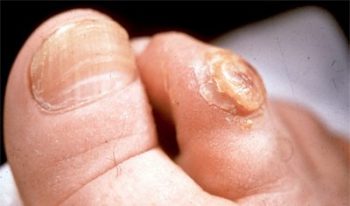Corns and calluses are areas of hard, thickened skin that develop when the skin is exposed to excessive pressure or friction. They commonly occur on the feet and can cause pain and discomfort when you walk.
Corns are small areas of thickened skin that usually develop on the tops and sides of toes or on the sole of the foot. Normally caused by wearing shoes that do not fit well which cause the foot to rub or high heeled shoes that put excessive pressure on certain bits of the foot that are not designed for weight bearing.
Corns also are often found on people suffering from a bunion or hammer toes.
Calluses
Calluses are hard and rough areas of skin that are often slightly yellow in colour. They usually develop on the feet around the heel area or on the skin under the ball of the foot
Calluses are usually larger than corns and do not have such a well-defined edge.
Calluses develop when the skin rubs against something such as a bone, shoe or the ground.
Activities that put repeated pressure on the foot, such as running or walking barefoot, can cause calluses to form. Hence athletes are particularly susceptible to them.
Treating corns and calluses
If you have a corn on your foot you should see a podiatrist/chiropodist, who can treat you.
You may be able to get this done on the NHS so ask your GP if you are eligible.
Treating corns
Corns on the feet will only improve if the cause of the pressure is removed.
Initially you can try applying corn plasters from over the counter, but they just treat the symptoms and not the cause.
So if they do not improve it is best to ask the opinion of a chiropodist as to the best solution.
Anyone suffering from Diabetes or any circulation problem should take special care of their foot problems and always consult the chiropodist.
Treating calluses
As with corns, you should only treat calluses yourself after a podiatrist has identified the cause and advised you about treatment.
The podiatrist may be able to treat corns or badly callused areas using a sharp blade to remove the thickened area of skin. This is painless and should help reduce pain and discomfort but is best left to the chiropodist to do.
They can also provide advice on self-care and prescribe special insoles.
Prevention of corns and calluses
You can also help prevent corns and calluses by looking after your feet and choosing the right shoes to wear.
Look after your feet by always drying thoroughly after washing them and then apply a special moisturising foot cream. Use a pumice stone or foot file regularly to gently remove hard skin.
Try to always wear comfortable footwear that fits properly.
Always shop for shoes in the afternoon when your feet are at their largest size
(feet always swell slightly during the day). Make sure you can move your toes inside the shoe and that that they are not banging on to the end of the shoe.
Try and avoid wearing heels as that increases the pressure on the front of your feet.
A podiatrist/ chiropodist can help you with all common foot problems including ingrown toenails and bunions.

